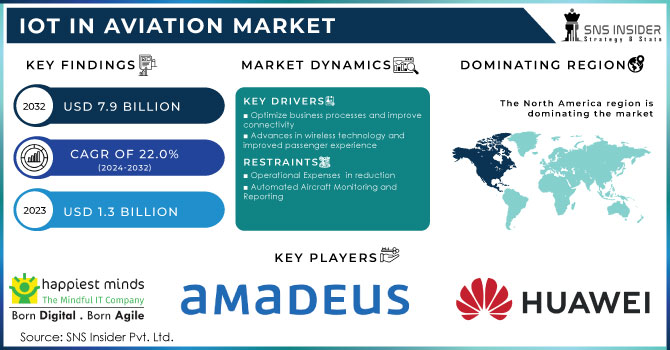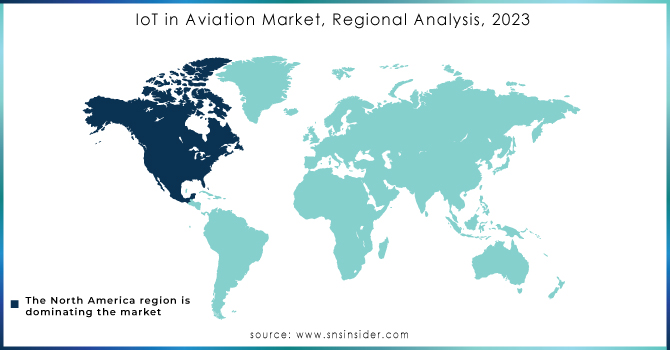IoT in Aviation Market Report Scope & Overview:

To get more information on IoT in Aviation Market - Request Free Sample Report
The IoT in Aviation Market Size was valued at USD 1.3 billion in 2023 and is expected to reach USD 7.9 billion by 2032 with a growing CAGR of 22.0% over the forecast period 2024-2032.
Internet of Things is a combination of functional and information technology integrated with visual intelligence to manage, send, and receive data without human interference. Technology benefits from analyzing human efforts and minimizing the need for personal interference. Machine-to-machine data produced has a wide range of uses but is often seen as a means of determining the health and condition of inanimate or inanimate matter.
Utilizing IoT solutions and services will add a new dimension to the complete digital transformation of the aircraft. IoT in Aviation is selected in a variety of industries and systems because of its features that include security, maintenance, efficiency, security, and customer information, and personalization. Innovation in IoT in the aviation industry paves the way for improved security and efficiency. Aviation IoT offers a wide range of applications for security and surveillance, connected cabinet, cargo tracking, aircraft traffic management, aircraft communications, and more.
Advances in Artificial Intelligence and Mechanics have great potential to stimulate market growth. This technology can be applied to a number of applications related to the aviation industry. For example, advanced face recognition AI is widely used to ensure safety, efficiency, and accuracy while ensuring passenger details. This in turn helps to reduce the waiting times associated with entry procedures while strengthening the biometric airport inspection procedures. Strong investment by government officials to build smart aviation infrastructure and greater competition between airlines to improve passenger information has particularly highlighted the implementation of IoT in the aviation industry.
MARKET DYNAMICS
KEY DRIVERS
-
Optimize business processes and improve connectivity
-
Advances in wireless technology and improved passenger experience
OPPORTUNITIES
-
Operational Expenses in reduction
-
Automated Aircraft Monitoring and Reporting
CHALLENGES
-
Concerns Related to Data Privacy and Cyber security
-
Multiple Stakeholders in the Aviation Industry
IMPACT OF COVID-19
The outbreak of the COVID-19 epidemic has had a profound effect on the business and industry of the aviation industry. Although the movement of passengers to domestic and international flights has been relatively easy since Q3/2020, recovery is slow. According to our research results, the domestic aviation market is expected to recover faster than its international counterparts. Government policy and guidelines regarding commercial air transport are also expected to have a direct impact on passenger capacity.
Airport participants and pilots complied with safety regulations by using advanced no-frills solutions for passengers. The deployment of IoT equipment is expected to gain momentum as most airport employees invest in hygienic methods and use touch-less technology. IoT has the potential to transform the current environment into intelligent infrastructure and improve overall business processes. Gathering vital information for the analysis and development of health-related decisions has become a modern phenomenon used in the aviation industry. Real-time temperature monitoring and infection detection have become an integral part of the journey. IoT devices with advanced temperature monitoring systems help monitor passengers' health and transmit information to affected authorities in real time.
Personal Electronic Device can play an important role in ensuring passenger safety during the COVID post-operative environment. The integration of IoT devices at airports with PEDs is expected to provide a wide range of self-help options and provide real-time data while helping to avoid direct contact and reduce line time. As a result, the epidemic is expected to encourage investment in IoT technology, thereby accelerating market growth.
The aviation industry has to deal with a few expensive assets, which can lead to higher operating costs. During this time, the increase in ship size in line with the growth of passenger traffic highlights the importance of cargo handling and tracking to achieve maximum efficiency. Aircraft asset management offers a variety of solutions to improve the overall productivity of personnel and aircraft operations. Part of the passenger experience is expected to emerge as the fastest growing segment, registering a CAGR of 24.4% from 2022 to 2028. The commercial aerospace industry utilizes technological advances to improve passenger knowledge. Using advanced technologies, such as bacon, NFC, and Wi-Fi, to engage passengers and understand their needs allows service providers to offer the best personal services. Access to a variety of information and infotainment systems may enhance the feeling of travel and eliminate unnecessary confusion that passengers experience during the journey.
It is also expected to emerge as the fastest growing segment in the forecast period in line with the growing popularity of the smart airport concept in various regions. IoT may open up opportunities for those in the aviation industry to provide solutions for passenger congestion, cargo management, and site management, and thereafter improve airport efficiency and efficiency. Partnerships between IoT service providers and airport operators are expected to create significant partial growth opportunities in the forecast period.
The proportion of pilots is growing steadily as airlines focus more and more on generating more revenue. IoT can play an important role in providing access to a variety of real-time data for airlines and in developing cabinet information for passenger aircraft. The proliferation of smartphones drives the need for internet connection to the aircraft and personalized entertainment solutions, thus opening up opportunities for airlines to maximize profits. The increasing adoption of smart cargo monitoring and climate control solutions in an upgraded cabinet to improve the mood of all passengers also contributes to partial growth.
KEY MARKET SEGMENTATION
By Component
-
IoT Devices
-
IoT Solutions
-
Services
By Application
-
Ground Operations
-
Passenger Experience
By End Market
-
Airports
-
Airlines
-
MROs
-
Manufacturers
REGIONAL ANALYSIS
During the projected period, North America is expected to be the largest market for IoT in aviation. The global desire to optimize airport operations is driving investments in IoT, as deploying this technology has the potential to increase transparency in airport operations. Airports must make data-driven decisions by using new technologies such as IoT, AI, and Block-chain as passenger volume and airline fleet size grow.
Asia Pacific is predicted to emerge as the fastest-growing geographical market, The increase in the mid-income population opting for air travel, strong expenditures in smart airport construction, and the expansion of airline operations in Asia Pacific can all be contributed to the boom. Domestic air travel has increased significantly in developing countries such as India and other Southeast Asian countries. Government measures to connect new air routes, such as India's Regional Connectivity Scheme, and a significant emphasis on improving handling capacity are some of the essential drivers driving regional market growth.

Need any customization research on IoT in Aviation Market - Enquiry Now
REGIONAL COVERAGE:
-
North America
-
USA
-
Canada
-
Mexico
-
-
Europe
-
Germany
-
UK
-
France
-
Italy
-
Spain
-
The Netherlands
-
Rest of Europe
-
-
Asia-Pacific
-
Japan
-
south Korea
-
China
-
India
-
Australia
-
Rest of Asia-Pacific
-
-
The Middle East & Africa
-
Israel
-
UAE
-
South Africa
-
Rest of Middle East & Africa
-
-
Latin America
-
Brazil
-
Argentina
-
Rest of Latin America
-
KEY PLAYERS
The Major Players are Happiest Minds Technologies, Amadeus It Group Sa, Walkbase, IBM Corporation, Huawei Technologies Co., LTD., Cisco Systems, Inc., SITAONAIR, Tata Sons Private Limited., Honeywell International Inc., Aeris, and other players
| Report Attributes | Details |
|---|---|
| Market Size in 2023 | US$ 1.3 billion |
| Market Size by 2032 | US$ 7.9 billion |
| CAGR | CAGR of 22.0% From 2024 to 2032 |
| Base Year | 2022 |
| Forecast Period | 2024-2032 |
| Historical Data | 2020-2022 |
| Report Scope & Coverage | Market Size, Segments Analysis, Competitive Landscape, Regional Analysis, DROC & SWOT Analysis, Forecast Outlook |
| Key Segments | • By Component (IoT Devices, IoT Solutions, and Services) • By Application (Ground Operations, Passenger Experience, Asset Management, and Air Traffic Management) • By End Market (Airports, Airlines, MROs, and Manufacturers) |
| Regional Analysis/Coverage | North America (USA, Canada, Mexico), Europe (Germany, UK, France, Italy, Spain, Netherlands, Rest of Europe), Asia-Pacific (Japan, South Korea, China, India, Australia, Rest of Asia-Pacific), The Middle East & Africa (Israel, UAE, South Africa, Rest of Middle East & Africa), Latin America (Brazil, Argentina, Rest of Latin America) |
| Company Profiles | Happiest Minds Technologies, Amadeus It Group Sa, Walkbase, IBM Corporation, Huawei Technologies Co., LTD., Cisco Systems, Inc., SITAONAIR, Tata Sons Private Limited., Honeywell International Inc., Aeris, and other players. |
| DRIVERS | • Optimize business processes and improve connectivity • Advances in wireless technology and improved passenger experience |
| RESTRAINTS | • Operational Expenses in reduction • Automated Aircraft Monitoring and Reporting |

